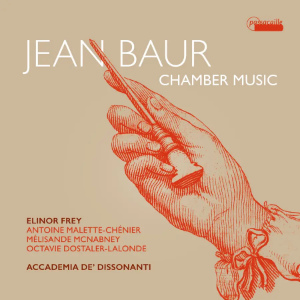
Jean Baur (1719-1773)
Chamber Music
Sonata for cello and bc in G minor, op. 1,4
Sonata for cello and bc in B flat, op. 2,2 ‘La Dupleïx’
Sonata for harp and keyboard in B flat, op. 8,3
Sonata for cello and bc in D minor, op. 1,3
Sonata for 2 violins No. 1 in F
Sonata for harp No. 6 in C
Accademia de’ Dissonanti/Elinor Frey
rec. 2022, Domaine Forget, Saint-Irénée, Québec, Canada
Passacaille PAS1123 [73]
It cannot be appreciated enough when performers delve into the repertoire of composers very few, if any, music lovers have heard of. That certainly goes for Jean Baur; never before I have encountered his name, and my edition of New Grove devotes a little more than three lines to him. The article on Baur (and his son and grandson) does include a work-list, which shows that the harp takes a central role in his oeuvre. That is no surprise as he was a professional harpist; his career points in the direction of what was to come: the harp as one of the most popular instruments in France in the second half of the 18th century.
The booklet to the recording to be reviewed here includes more information about Baur than New Grove. He was born in Bouzonville, close to the German border, and arrived in Paris around 1745. At that time the harp did not play a major role in music life. The first harpist to perform at the Concert Spirituel was the German Georges-Adam Goepfert in 1749. This may explain why Baur did not publish any music for the harp at that time. Interestingly, his Op. 1 was a set of six sonatas for cello and basso continuo (1751?). There is no reason to think that Baur was playing the cello, but Elinor Frey, in her liner-notes, states that his writing for the cello is idiomatic enough to suggest that he must have had some knowledge of it. At the time of publication, the cello had established itself as a major force in the music scene. Geminiani had published a set of cello sonatas (his Op. 5), and some of the main cellist-composers were Jean Barrière and Salvatore Lanzetti. Baur’s first set of cello sonatas was followed by a second, published as his Op. 2 (1756?). The dates of publication of both collections are not on the prints themselves, but added by the Bibliothèque nationale de France where they are preserved. Therefore, it is impossible to say when these sonatas were written.
The sonatas from the two collections include features that show the state of affairs in cello playing. They include double stops, arpeggios, passagework, appoggiaturas and suspensions. In the slow movement of the Sonata in B flat, op. 2,2 we find sons harmoniques, “which ask the cellist to play melodies using the light, fluty sound created by harmonics, a new and perhaps ‘trending’ technique on the cello in the 1750s.” (booklet). This sonata also has a nickname, in the tradition of French character pieces. La Dupleïx very likely refers to Joseph-François Marquis Dupleïx, governor-general of French India at the time.
In addition to three sonatas for cello and basso continuo, the programme also includes a sonata for two violins. It is taken from a collection of six sonatas, two for violin and basso continuo and four for two violins; they were published in 1774. Here the first sonata is performed on two piccolo cellos; according to Elinor Frey these instruments were used as substitutes for treble instruments, such as the violin and the flute. “[The] practice of reading treble clef one octave below pitch was a common skill among professionals and amateurs alike”. The two cellos sometimes play in parallel thirds. They often swap roles: one plays the melody, the other takes the role of accompaniment.
The two remaining pieces attest to Baur’s skills at the harp. Around 1770, he published a set of four sonatas for harp. In two, it is accompanied by a keyboard instrument, a harpsichord or a fortepiano; the performers have opted for the latter. The other two sonatas are for harp with an ad libitum violin part. At the time many pieces for keyboard with an ad libitum part were written. It is interesting to note that Baur was the earliest composer who made a distinction between the harp and the keyboard. That comes to the fore in the Sonata in B flat, in which the parts for the respective instruments are not interchangeable.
Composers often wrote pieces for a solo instrument – without accompaniment – for their own performances. Therefore they were mostly not published. That may also be the case with the Sonata in C for harp solo. It has been preserved in manuscript, and probably dates from the 1760s. It comprises three movements; the central movement is a minuet, one of the most popular forms in the mid-18th century.
In recent years Elinor Frey has come up with various recordings of little-known repertoire for her own instrument. Here, she is teaming up with some colleagues to present an interesting and musically compelling portrait of an early representative of the harp in France, who apparently knew his way around the cello as well.
Elinor Frey, Octavie Dostaler-Lalonde (cello [piccolo]), Antoine Malette-Chénier (harp) and Mélisande McNabney (harpsichord and fortepiano) are the ideal advocates of Baur’s music, and show that he is someone who deserves his place on the map of French music of the early classical era. His oeuvre is modest in size, but not in quality, and it is to be hoped that more of it is going to be recorded. This disc is very enjoyable; thanks to the way the programme has been put together, it offers much variety, and the playing of all participants is of the highest order.
Johan van Veen
www.musica-dei-donum.org
twitter.com/johanvanveen
Help us financially by purchasing from




















